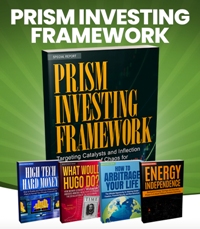 The stock market, as measured by the S&P 500, continues to inflate. But this isn’t a sign of economic health. In fact, a scratch below the surface reveals an economy that is much weaker than advertised.
The stock market, as measured by the S&P 500, continues to inflate. But this isn’t a sign of economic health. In fact, a scratch below the surface reveals an economy that is much weaker than advertised.
Several decades ago, the stock market was viewed as a forward-looking animal. A place where investors considered expectations about future earnings and performance to make decisions affecting share prices. Those days are long gone.
These days the stock market is purely speculative. There’s a large cohort of workers who blindly pour money into index funds every two weeks through their company sponsored retirement accounts. Others, under the spell of AI hype, believe we’re in the early stages of the greatest economic boom since the railroad. They trip over themselves to grab a piece of the mirage.
Thus, share prices and index levels do not provide much meaningful information about the state of the economy. Warning signs are no longer found on Wall Street. To understand what’s happening and what’s coming next you must look elsewhere.
For example, U.S. heavy truck sales – the nuts and bolts of the economy – are tanking. We’re not talking about a little dip. The numbers are flashing red.
In August, heavy truck sales – the big Class 8 rigs that haul the vast majority of our stuff – plummeted by a whopping 20,000 units to an annualized rate of 422,000. That’s the lowest we’ve seen since January 2022. And if you look at the three-month moving average, which smooths out the monthly noise, it has slipped to 438,000 – a level not seen since the dark, days of the 2020 lockdowns.
National Slowdown
This isn’t just bad news for truck manufacturers. It is an unpleasant situation for the entire country. Why? Because heavy truck sales are one of the most reliable leading economic indicators there is.
Who buys a brand-new, $150,000+ Class 8 truck?
Companies that need to haul massive amounts of goods. These are companies that make and build stuff. Manufacturers, construction companies, and retailers. This kind of purchase isn’t an impulse buy. It’s a massive capital expenditure based on a company’s forward-looking confidence in the economy.
The decision to purchase heavy trucks is based on what’s happening in the physical world. Not the fictitious world of Wall Street.
When a CEO signs off on a fleet of new trucks, it’s because he or she expects demand for their products to be so high over the next five to seven years that they need to increase the company’s logistics capacity. It’s an investment in future economic expansion.
The reverse is also true, and this is why the decline in heavy truck sales is important. When sales drop off a cliff, it means existing trucking fleets are already underutilized.
By this, there’s slowing freight demand and a weakening outlook for manufacturing and construction. Thus, CEOs hit the pause button on significant, long-term investment because they anticipate a slowdown in the movement, production, and sale of physical goods.
Heavy trucks move the raw materials to the factories and the finished goods to the stores. Historically, a sharp decline in heavy truck sales has preceded nearly every major recession. When the gears of commerce grind to a halt – which is what a slump in trucking indicates – a slowdown is virtually guaranteed to spread across the whole economy.
But it’s not just heavy truck sales that are lacking…
Front-Line Warning
This week the Institute for Supply Management (ISM) released its latest Purchasing Managers’ Index (PMI). The PMI is like a monthly report card for the U.S. economy. It looks at the health of the manufacturing or services sector.
The PMI comes from the ISM, which is a group of professionals who handle procurement and supply chain items. These purchasing managers are the ones buying all the materials, parts, and services that companies need. So, they’re on the front lines of business activity and have the best view of what’s happening right now.
Every month, the ISM surveys these purchasing managers. The questions are very simple: Did your new orders go up, down, or stay the same? What about production, employment, and inventories?
The PMI is calculated by rolling up those “better,” “worse,” or “same” answers into a single, simple number between 0 and 100. A reading above 50 means the sector is generally expanding or growing compared to the previous month. More managers reported improvement than decline. A reading below 50 means the sector is contracting or shrinking. More managers reported a slowdown in business than growth. The further below 50 it drops, the faster the contraction.
For months, the manufacturing PMI has been stuck in contraction territory (a reading below 50). Specifically, the PMI reading for September came in at 49.1. This aligns with the trucking slump, as manufacturers reduce their output and thus their need for freight transport.
Moreover, the PMI is a leading economic indicator. A company doesn’t wait for a recession to be officially declared to stop buying raw materials. They sense a slowdown before it shows up in big government reports like GDP or unemployment figures.
When purchasing managers start cutting back on orders, slowing production, and letting their hiring cool off, that’s a direct signal that an economic slowdown is likely coming.
Keep Your Eyes on the Road
Household and business debt are at record levels: $20.5 trillion and $21.9 trillion, respectively. A decade ago household debt was $14 trillion and business debt was $13.2 trillion.
As of Q2 2025, credit card balances totaled $1.21 trillion outstanding, auto loan balances stood at $1.66 trillion, and student loan balances were at $1.64 trillion.
The fact is, the U.S. economy still needs to reckon with the massive amounts of debt that resulted from the Federal Reserve’s actions during the government mandated lockdowns of 2020-21. For years, the Fed kept interest rates artificially low and dramatically expanded the money supply. Businesses and consumers loaded up on debt in kind.
Of course, when economic activity slows down, debts pile up. After debt piles up, it goes bad. Individuals and businesses declare bankruptcy. Lenders take the losses. These are the sorts of disagreeable conditions that take place during recessions.
Plunging heavy truck sales are a perfect signal of the coming liquidation phase. The excess inventory of trucks (and the slowdown in orders for new ones) reflects the over-expansion of the logistics and manufacturing sectors during the cheap-money boom.
Businesses thought they needed massive capacity to keep up with the credit-fueled demand. Now, as the false demand has exhausted itself, they realize their capital – those expensive, under-utilized trucks – are a liability that must be reduced.
The trucking decline won’t be the cause of the recession. Rather, it’s an indication that the boom is turning to bust. What’s more, a new cycle of Fed rate cuts won’t stop it. However, it will fuel greater distortions throughout the economy.
Currently, stock market investors are taking on major risk, pushing indexes and valuations to all-time highs. Yet the economy is weakening.
So, forget the mania on Wall Street. The real story is on the highway and in the factory. When trucks stop rolling and purchasing managers hit the brakes, you’ve got your clearest warning. The inflated stock market is betting on a boom, but the physical economy is whispering bust.
Keep your eyes on the road.
[Editor’s note: Join the Economic Prism mailing list and get a free copy of an important special report called, “Utility Payment Wealth – Profit from Henry Ford’s Dream City Business Model.” If you want a special trial deal to check out MN Gordon’s Wealth Prism Letter, you can grab that here.]
Sincerely,
MN Gordon
for Economic Prism




